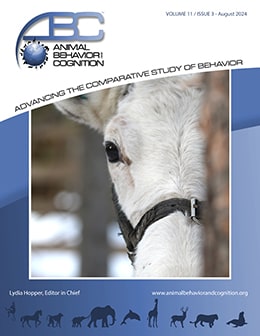Vol 11, Issue 3, August 2024
Specifically Unspecific - Simple Devices as Feasible and Effective Enrichment for Small Mammals
Citation
Göbel, M., Kaiser, S., Richter, H., Wagner, P., & Wehrenberg, G. (2024). Specifically unspecific – Simple devices as feasible and effective enrichment for small mammals. Animal Behavior and Cognition, 11(3), 305-329. https://doi.org/10.26451/abc.11.03.05.2024
Abstract
Although enrichment is an essential part of modern zoo animal husbandry, research on effective enrichment for small mammals is scarce, albeit they are regularly kept in zoos. To develop solutions that are inexpensive, readily applicable, and adaptable for a variety of species, we investigate whether three types of simple enrichment devices (SEDs) – object, olfactory, and food-motivated – elicit positive interactions in various zoo-housed small mammal species. In this preliminary exploration study, we evaluate if amount of enrichment interactions, display of behavioral stress reactions, and display of stereotypic behaviors vary, if different types of SEDs are provided. Therefore, we observed 39 individuals of ten species, most of which are underrepresented in enrichment literature: Eastern quoll (Dasyurus viverrinus), round-eared elephant shrew (Macroscelides proboscideus), aardvark (Orycteropus afer), southern tamandua (Tamandua tetradactyla), northern Luzon giant cloud rat (Phloeomys pallidus), green acouchi (Myoprocta pratti), South African springhare (Pedetes capensis), aye-aye (Daubentonia madagascariensis), golden lion tamarin (Leontopithecus rosalia), and Javan mouse-deer (Tragulus javanicus) housed in Frankfurt Zoo, Germany. All focal individuals interacted with at least two types of SEDs and around 80% interacted with all types of SEDs, resulting in a considerable amount of time spent with the enrichment. There was a preference for food-motivated enrichment. Neither behavioral stress reactions nor stereotypic behaviors differed if different types of SEDs were present. Model selection showed that GLMs explaining enrichment interactions improved if the variable ‘individual’ instead of ‘species’ was included, suggesting that reactions towards unspecific SEDs might be more individual-driven than species-specific. Because individuals of all species chose to interact with the SEDs and we did not find behavioral indicators for stress elicited by the SEDs, we advocate for the regular provision of SEDs for small mammals in human care.
Keywords
Animal welfare, Zoo, Behavioral enrichment, Stereotypy, Animal husbandry, Multi-species approach
